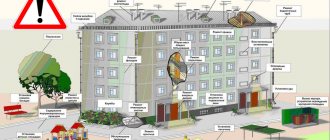Container sites for waste: SanPiN requirements, sizes, standards
A properly equipped container site is necessary to maintain order in the local area.
To ensure that residents are satisfied and regulatory authorities do not impose fines, the management company must comply with the requirements established by law for the improvement and maintenance of this facility.
SanPiN requirements for waste container sites
The rules for arranging areas for garbage containers are described in documents SanPiN 42-128-4690-88 and SanPiN 2.1.2.2645-10.
The first was adopted in 1988, the second in 2010. Since August 15, 2010, the old SanPiN has been applied in points that do not contradict the new one.
They provide sanitary standards for servicing populated areas.
When placing a container site, installing tanks on it, and drawing up a schedule for waste removal, the management company is guided by SanPiNs. Work is paid according to Article 225 of KOSGU.
SanPiN requirements for container sites are taken into account when designing new residential complexes.
Features of the location of garbage containers
It is allowed to install large 20 m3 containers for construction waste for 1 day with the permission of the city architect and the local SES.
Sites for containers for collecting household waste must comply with the following sanitary standards:
- free passage to the bins for garbage trucks;
- closed containers are placed on a flat asphalt or concrete platform with a slope for easy movement;
- the fence covers the waste container area on three sides;
- Shrubs and trees are planted around;
- a canopy for solid waste containers was installed to protect from precipitation;
- storage tanks are closed with tight lids;
- the tanks are located at a distance of 20 m from residential buildings, children's and sports complexes, and recreation areas;
- the distance to garbage containers from a residential apartment building is less than 100 m;
- the number of containers for an apartment building is calculated based on the area, but not more than 5.
Garbage containers are installed at a certain distance from institutions and public places.
For hospitals and other medical institutions - 50 m, for shopping centers and markets - 30 m, in parks - 50 m from the main crowded place, on beaches - 1 large garbage dump per 4000 sq.m.
It is not allowed to place waste tanks next to pedestrian paths, roads for vehicles, flower beds, or narrow passages.
Tanks are removed from the residential sector at least once every 7 days.
Fencing of a waste container area
Waste sheds are made from a variety of materials. The available material for fencing the site is corrugated sheeting. Construction companies offer options that vary in area and design.
A budget option – a platform for 2 standard tanks with a volume of 0.8 m3. The height is from 1 m, as required by Sanitary Regulations, and up to 2.5 m. The structure has a roof: the tanks are protected from precipitation and last longer.
Fencing for 3 containers is in demand.
The container area is fenced and equipped with lockable gates
A reliable option is a fence with a gate.
It looks aesthetically pleasing and meets the requirements of SanPiNov: garbage does not fly out of it, stray dogs do not get into it and do not scatter waste.
This type of fencing for waste container sites is suitable for courtyards of apartment buildings, kindergartens, schools, and hospitals.
Distance from garbage containers to the playground
Installation rules require that waste collection areas be located at a distance of at least 20 m from playgrounds. The greatest distance to garbage cans is 100m. A mark must be placed on the fence indicating that there is waste there.
Selection of trash cans
When choosing tanks, take into account population density and the solid waste removal schedule. In the residential sector, storage tanks with a volume of 0.8 - 1.1 cubic meters are installed.
They are made of plastic or metal.
In densely populated areas and near public places with large crowds of people, it is possible to use containers with a volume of 8 m3.
You will be interested! Garbage reform in Russia: all the pros and cons
Garbage containers should have tight-fitting lids. Models with a pedal that opens the lid are convenient and hygienic.
Modern tanks with underground storage, common in Europe, are not yet often found in Russia. They are roomy, comfortable, hygienic, but expensive (the cost of one tank is from 400,000 rubles) and require special equipment for maintenance.
and maintenance of container waste collection sites
container sites lies on the shoulders of the management company. In the absence of special equipment, the company enters into an agreement with a third party to clean the container site.
There are two ways to dispose of waste at an organized landfill:
- with changing collections. Containers are removed along with waste and replaced with clean ones;
- with irreplaceable collections. The contents of the containers are unloaded into a garbage truck and the containers are placed back.
Sanitation of waste bins
The rules for sanitizing containers are established by local SEN authorities.
During the warm season, non-replaceable containers are processed on site at least once every 10 days, replaceable containers are processed after each removal of filled tanks. The territory is equipped with drainage into a storm sewer.
Replaceable containers are washed in designated areas by specialized organizations.
Types of sites
The container platform for waste collection is located on an asphalt or concrete platform with a slope of 0.02% towards the entrance for the garbage truck. A fencing of container sites on three sides with a height of more than 1 m and a roof are required.
Solid waste sites
For household waste, fences of different sizes are made depending on the needs of residents: the smallest are designed for 2 containers, the largest - for 6. They can have a locking gate or free entry. They usually have a non-solid design: for ventilation, a gap is left between the walls and the roof.
MSW sites
In areas with a concentration of business centers or retail spaces, fencing for solid municipal waste is in demand. They are distinguished by their large capacity: 6 standard-sized containers or one 8-cubic storage tank are installed there.
Standards for placing trash cans for private areas
In the private sector, residents decide for themselves where to place garbage disposals, in what quantity and how to equip garbage disposals.
Container sites for waste are located 10 m from a private residential building.
In cases of conflict, public representatives, the Council of Deputies, and the district administration help resolve the problem.
It is advisable for owners of private houses to dispose of organic waste on their own site, while inorganic waste should be disposed of in a container.
Modern container yards
The management company responsible for servicing the settlement must:
Container site security measures
Garbage cans made of metal are stolen to be sold for scrap.
Utilities take safety precautions to preserve property.
- Garbage fences with gates are installed. They do not prevent trash from being thrown out, but they do prevent containers from being stolen.
- Locks for each container. Keys are issued to garbage truck drivers.
- Using welding, the logo of the management company is applied to the tank: attackers will no longer be able to sell them for scrap or use them elsewhere.
- Alarm installation.
- Use of CCTV cameras. A costly method, but effective.
Rules for installing garbage containers
The issue of location of waste containers is one of the most discussed among residents of apartment buildings and management companies.
The cleanliness of the yard depends on the correct location of garbage cans. Important! Controversial issues are regulated by SanPiN 42-128-4690-88 and SanPiN 2.1.2.2645-10. They describe the necessary items for equipping and maintaining the cleanliness of public and courtyard areas, as well as the conditions for arranging apartment buildings and residential premises.
Based on these documents, you can calculate the required number of containers, clarify the location of the tanks, and set the time interval for waste removal.
Features of the location of garbage containers
According to sanitary and epidemiological requirements, waste collection areas must meet the following conditions:
- The presence of a flat platform, covered with asphalt or concrete, fenced with a fence, wall, mesh or high curb on 3 sides. Be sure to provide a slope and free passage for garbage trucks.
- Equipping storage bins with tight lids.
- Plants and bushes are planted and green areas are created near the location.
- The location of containers must be at least 20 m from inhabited premises, public areas, gazebos, and recreational areas for residents. In conditions of limited space, the distance, by agreement, is reduced to 9 m. The maximum distance from houses is no more than 100 m.
- The number of containers is calculated taking into account the area of the yard, but the total number should be no more than 5 pieces.
- Fences are made at least 1 meter high. This way, garbage does not fall into the surrounding area. In recent years, special platforms are increasingly being made. Sketches of such projects are approved in accordance with the established procedure.
Medical centers, hospitals, clinics and other health institutions should be located 50 meters from the waste collection area. The area of waste sites in such cases should not exceed 40 square meters.
In shopping centers and market squares, containers are placed 30 meters from the objects.
In city parks, squares, and recreation areas, trash cans are located 50 meters from places with large crowds of people; on the beaches, 1 volumetric storage bin for solid household waste is installed for every 4,000 square meters.
Important! If it is not possible to place container sites in accordance with the specified rules, then the location of garbage cans is chosen by apartment owners.
It is prohibited to place garbage containers near footpaths, roadways, lawns, arches and narrow passages. SanPiN allows short-term placement of bins for storing construction waste at work sites for 1 day. In such situations, the installation of containers must be approved by the chief architect of the district and the city sanitary control stations
Garbage disposal near residential buildings must be carried out at least once every seven days.
Standards for placing trash cans for private areas
For private houses, the location of garbage disposals and waste bins is determined by the residents themselves. Containers can be located at a distance of 8-10 meters from the household. If controversial situations arise, the issue is resolved with the participation of public representatives, commissions of the district administration, and the Council of Deputies.
The service management company is responsible for:
- equipping a site for installing garbage cans near residential buildings;
- transport solid waste to specially equipped landfills;
- compliance with sanitary standards for cleaning the territory;
- organization of access and illumination of waste containers.
The housing and communal services are also required to install small trash cans near each entrance. The distance between these objects should not exceed 100 meters. The urns are emptied as they are filled. Cleaning is carried out by a responsible organization.
Selection of trash cans
When equipping sites, the occupancy of houses, filling time and other parameters must be taken into account. Most often, storage bins with a volume of 0.8 - 1 cubic meter are used. m. Near business centers and public places, 8 cubic bins are usually installed.
Important! In large cities today you can find special garbage containers for solid waste: they are buried 1.7 m underground. The lid of such a storage facility is equipped with special latches so that the smell of waste does not penetrate outside.
Advantages of these containers:
- capacity;
- convenience;
- no odors;
- environmental friendliness.
How to avoid theft
Often, utility services resort to different ways to protect garbage containers from theft:
- An anti-theft lock is installed on the tanks. In such cases, the keys are held by the garbage truck drivers;
- use underground urns described above;
- A company mark or logo is applied to the storage hopper by welding. This makes it difficult to hand over the tank to a scrap metal collection point;
- sometimes the site is equipped with surveillance cameras, but this is a rather expensive method;
- use of alarms.
Where to contact in case of violations
To resolve controversial issues, commissions are appointed, which include the manager of the housing and communal services company and representatives of the district administration.
Local residents have the right to file a complaint with Rospotrebnadzor if the rules for installing containers are violated.
The administrative body of the district approves and agrees on:
- average annual volume of household waste of various forms per inhabitant;
- organizations carrying out sanitary control;
- contracts for waste disposal.
You can study in more detail the documents regulating compliance with the rules for installing garbage containers here:
- SanPiN 42-128-4690-88 “Sanitary rules for the maintenance of populated areas.”
- SanPiN 2.1.2.2645-10 “Sanitary and epidemiological requirements for living conditions in residential buildings and premises.”
Rules for installing garbage containers Link to main publication
Source: https://okommunalke.ru/uslugi/pravila-ustanovki-musornyh-kontejnerov
Arrangement and fencing of container sites for waste
To ensure rapid collection and removal of waste, container sites should be organized in the territories of residential buildings, industrial enterprises, organizations, shops and construction sites.
Containers and storage bins are installed there where waste can be disposed of. The collected waste is transported to landfills and recycling plants.
To avoid mixing different types of waste and reduce their impact on the environment, separate waste collection is organized in many places.
The container area is designed for convenient waste removal
Organization of container sites
Sites for garbage containers are organized in accordance with the requirements of SanPiN 42−128−4690−88. They must meet the following requirements :
- have a location convenient for residents and vehicles transporting waste;
- be isolated from the residential area;
- be regularly serviced;
- be practical and easy to use.
From this video you will learn about the purpose of container sites:
These requirements must be met not only by sites near residential buildings, but also by those located in isolated areas, in dacha cooperatives, and in recreational areas. A properly organized waste disposal area looks like this:
- Located at a distance of at least 20 m and no more than 100 m from residential buildings, playgrounds and other recreational areas. There are no obstacles to the passage and operation of specialized transport.
- The number of waste bins corresponds to the number of people living in the residential area and paying for waste removal, as well as the storage period and waste accumulation standards. There can be no more than 5 garbage containers and 1 storage bin in one place. The distance between garbage cans is 35 cm. If the population increases, then it is necessary to accordingly increase the number of containers and places for waste collection.
- The area for garbage containers is installed on a concrete or asphalt surface and equipped with a waterproof roof.
It is accessible to people and cars. The roof over the container platform must be waterproof - The waste area must be fenced on at least 3 sides. The height of the fence is from 1 m. It is coated with an anti-corrosion compound. There are green spaces around.
- When the air temperature is below 5ºC, garbage is removed every three days. If the temperature is above 5ºC, then garbage is removed daily.
- In summer, waste bins are disinfected at container sites. Management companies must also regularly carry out deratization of waste accumulation sites.
- Container places are equipped with signs indicating the presence of garbage cans.
A janitor can clean the area for containers. To prevent the spread of unpleasant odors, insects and rodents, it should be cleaned once a week or after garbage collection.
Containers for waste collection
Containers and storage bins can be installed at waste sites. Containers must meet the following requirements:
- have a reinforced top edge so that a forklift can grab it;
- sealed with a lid;
- have wheels for ease of movement.
Bins have more capacity. They are used both for collecting household waste and bulky waste. The capacity of standard bunkers is 8 m³.
High-strength steel is used for their manufacture. To ensure high load-carrying capacity of products, sheets of large thickness are used.
Several types of bunkers are available:
- ordinary;
- with lids;
- with folding sides.
: construction site fencing. Waste bins are more convenient for collecting and storing waste, unlike conventional bins
Their choice depends on what special equipment will remove waste from a particular site. Some machines find it more convenient to work with conventional hoppers, others with folding sides. Bins with lids are the most hygienic.
They allow you to keep the surrounding area clean. Garbage collection containers can be painted in various colors. Household waste is not classified as hazardous, so there are no rules for coloring it.
The modern market offers a large number of different containers and bins for waste. You can always choose products that are best suited for a specific site.
Violation of the law
When organizing container sites, gross violations of waste collection requirements are not uncommon. These include:
- installation of garbage containers near entrances;
- lack of fencing of waste container areas;
- lack of concrete base;
- installation of garbage cans outside the container site;
- use of storage bins without permission or for other purposes.
All this can be recognized as an administrative offense, for which a fine will be collected from the developer, management company or other responsible organization.
If waste is not removed from a residential area, then residents who pay for this service can file a claim with the management company. It is compiled in any form.
The claim must contain the signatures of at least 2 residents and the head of the house. The management company is obliged to consider the claim within three days and correct the situation within 10 days.
A recalculation must also be made for the time when garbage collection was not carried out.
Correct installation of a container site is an important condition for the normal life of residents of apartment buildings.
Timely waste removal ensures the absence of harmful substances and unpleasant odors in residential areas.
It prevents the proliferation of rodents, flies and other unpleasant insects that are carriers of dangerous infectious diseases.
Source: https://zaborprofi.com/postrojki/obustrojstvo-kontejnernyh-ploshhadok.html
Formula for calculating the volume of solid waste and the cost of removal services
To calculate the cost of removing 1 cubic meter of solid waste, you first need to find out:
- volume of solid waste (V tbo);
- average productivity of vehicles (Рaver);
- number of collection points;
- distance between collection sites (L sat);
- distance of transportation of solid waste to the places of its neutralization (L t p);
The volume of solid waste removal (V tbo) is calculated by the formula: V tbo = Chnas (Ntbo + Nkgm), (Chnas – population, people; N solid waste, Nkgm – rate of accumulation of solid waste and rate of accumulation of KGM, respectively, cubic m/person ).
Garbage removal by container
Law No. 52-FZ states that all waste must be collected, stored and transported in a safe way. This involves the use of specialized containers and vehicles. The volume of containers varies from 8 to 32 cubic meters, the choice depends on the needs of the customer.
Some companies provide online calculators that allow you to calculate the number of containers per month for solid waste removal. You can find out the cost of removal once a week, services per month.
Garbage removal by dump truck
For economic benefit, it is recommended to remove garbage by dump truck if the volumes of solid waste are large enough.
Factors affecting the cost of garbage removal
The cost of transporting solid waste is influenced by several conditions that are taken into account in the calculations. These may be: volume of waste, amount of payment for removal and disposal, distance from the landfill. If the garbage has a high hazard class, then the company is required to have a license and special equipment, which may affect the cost of services.
Formulas for calculating the volume and weight of garbage
To calculate the volume, you need to multiply three values of the existing waste: length, width, height. The resulting value is measured in cubic meters if the indicators were measured in meters.
To calculate the weight you need: the volume of the building, the volume of waste (divide the first value by 2-3), the weight of the scrap (multiply the volume of waste by Mob - an indicator of volumetric mass). The latter value depends on the material from which the scrap is made. It varies from 2400 to 1200. What happens is the weight of the waste (tons).
Methodology for calculating the quantitative characteristics of emissions of pollutants into the atmosphere from landfills of solid household and industrial waste.
It is not always possible to restore areas used as landfills, which harms the environment and the economy. Calculation formulas taking into account the chemical composition of waste are known to specialists and are available for general use as a mathematical model.
Distance from garbage containers to a residential building: SanPiN and SNiP standards
In places where garbage is stored, rodents, cockroaches and other animals and insects gather, spreading various diseases.
To protect your home from unwanted neighbors, you must observe the distance from garbage containers to a residential building and other requirements of regulatory documents SanPiN and SNiP standards.
If stored improperly, waste can cause a fire, poison the air with toxic odors, and seep into groundwater.
Garbage cans near a residential building
Requirements for organizing space for garbage containers
The basic requirements for the distance to various objects and the organization of sites for containers are set out in SanPiN 42-128-4690-88.
It states that the minimum distance from the house to the garbage container is provided for by sanitary standards and is 20 m.
For ease of use, the maximum distance is designed.
Experts have determined that it is convenient to use garbage cans if they are located no further than 100 m. For greater distances, it is inconvenient to travel daily with a bag or bucket of waste.
The place for the container must be arranged properly.
A concrete or asphalt platform is made, protruding 100–200 mm above ground level. The tanks are placed on it. Water from the ground should not get into the containers after rain and increase the rotting of their contents.
On one side there is free space, a road equipped for a garbage truck passes through. It should be covered with gravel or have a hard surface that allows access in any weather. The area with containers must be fenced on the three remaining sides.
The number of garbage cans is calculated according to the number of citizens living in the house or two neighboring residential buildings for which the bins are installed. A maximum of 5 of them are allowed on one site.
As a recommendation, it is indicated not to place garbage cans on the side of the front entrance to the house. In addition, between the house and the garbage container there should not be:
- recreation areas;
- sports grounds;
- pedestrian and bicycle paths.
Near the place where the trash can is located, dogs and other animals are allowed to walk in designated areas. Owners must ensure that animals do not run into the area where garbage is stored.
Requirements for installing garbage cans
According to the requirements of the sanitary doctor (SanPiN 2.1.2645-10 Art. 8.2.4, 8.2.5), the area allocated for the placement of garbage cans must have a hard surface (asphalt or concrete) and be located at a distance of no closer than 20 meters from residence or accumulation people, but not further than 100 meters. In addition, the area with containers must be fenced and planted with greenery. The maximum number of containers is no more than 5 pieces with mandatory daily garbage collection.
If in multi-apartment residential buildings the task of selecting and installing a container lies with the regional operator, then for owners of individual housing and business owners, the question of a properly selected container for collecting and storing waste serves as a guarantee of compliance with sanitary requirements and cost savings.
Garbage containers sanitary standards (2 videos)
Installation, arrangement and maintenance of a container site for solid waste collection
An ecological and rational solution for eliminating human waste is to equip residential complexes with container sites.
Recently, apartment owners in multi-storey buildings are increasingly abandoning the usual garbage chutes, preferring to install sites equipped with waste collection containers.
The modern market offers a wide range of containers for accumulating various types of waste, allowing you to choose the color and configuration.
The main advantages of these waste collection sites are ease of maintenance and aesthetic appearance, which becomes a harmonious addition to the architecture of modern residential complexes.
What is a register of container sites
In addition, the Government of the Russian Federation decided to create a unified register of container sites. The register is a database that includes all information about each container site located within the city.
- Location: address data, geographic coordinates and layout to scale on the map.
- Technical characteristics: material from which the fence is made; occupied area, number of garbage cans.
- Information about the owner of the territory.
The owners provide the following information:
- Legal entities indicate the name of the organization (in full), registration data and actual address.
- Individual entrepreneurs indicate passport data, registration number and residential address.
- Individuals provide information about their actual residential address, contact information and passport information.
The register contains information about the sources of waste.
Requirements for organizing the site
The standards for equipping MSW accumulation sites and their maintenance are regulated by SanPiN documents.
- To equip a waste collection site, it is necessary to obtain the consent of the city municipality, the SES service and the company involved in servicing the territory.
- The number of garbage cans installed on the premises depends on the number of people living in the residential complex. Installation rules limit this quantity to 5 containers.
- The container site must be equipped with a concrete base and be on a slope to facilitate the movement of garbage cans.
- The container site is fenced on 3 sides; options for making a canopy are not excluded. Places where waste accumulates are fenced with metal structures or plantings that allow you to keep the waste within the designated area.
- Containers are intended exclusively for the accumulation of solid municipal waste; the discharge of construction and industrial waste is prohibited.
- Garbage cans are equipped with tight-fitting lids that perform the following functions: protect from moisture during precipitation, prevent the spread of garbage in strong winds, and prevent the entry of animals
Regulatory documents
Installation of container platforms requires compliance with the norms and rules provided for in the following documents:
- SanPiN 2.1.2.2645-10
- SanPiN 42-128-4690-88
Since this document includes many requirements, most owners use the services of companies that install containers and remove waste.
Types of sites
There are two types of container sites:
- Open type.
- Closed type.
Most often, open-type container sites can be found in residential areas. The popularity of this type is due to its low cost and ease of use. This option is budget-friendly due to the lack of doors.
Indoor venues are in less demand. They are equipped with swing or sliding doors; the equipment may also include a lock or sliding mechanism.
The size of the container site is usually designed to accommodate several containers. To collect waste from one apartment building with several entrances, 3-4 garbage cans will be enough.
Some projects include landscaping by installing not only containers for collecting solid waste, but also containers for accumulating plastic and paper waste.
Types of waste collection containers
In Russia, the following types of containers are used for collecting household waste:
- Regular containers.
- Storage bins for bulky waste.
- Bins for small-sized waste.
For some models of waste bins, the package includes a lid and wheels.
Bulky solid municipal waste, such as construction waste and parts of old wooden furniture, must be disposed of in storage bins.
This type of container is distinguished by capacity and load capacity. The storage hopper is equipped with special clamps that allow it to be mounted on a garbage truck.
Most models on sale are made of high strength steel and hold about 8 cubic meters of waste. To increase the loading capacity of the bunker storage, thicker metal sheets are used.
The presented assortment allows you to select waste storage devices that meet all requirements and financial capabilities.
The most budget-friendly option are containers and bunkers that are completely or partially open. Expensive models have the ability to separate discarded waste and are locked using swing doors or pendulum curtains.
Layout
The organization of a place for accumulation of solid waste, as well as its placement, requires coordination with municipalities.
The procedure for determining the location of container sites is approved by the administration of the city or locality.
In this area, at the request of the owners, it is possible to install a container platform. If necessary, it can be moved to a more convenient place. The location of the waste accumulation site can be discussed at a general meeting of apartment owners of a multi-storey residential building.
The layout of municipal solid waste accumulation sites is published in a unified register on the public portal of the city’s municipal authorities.
Who equips
From the beginning of 2020, residents of the Russian Federation, in order to install or move a container site to a more convenient location, can contact the city self-government authorities.
All data on responsible persons is reflected in a single register, which is published on the public portal of municipal authorities.
Who serves
container sites do not require large financial investments. Cleaning container areas is the responsibility of the janitor. Responsibility for timely waste removal rests with the management company.
The frequency of emptying trash cans depends on the temperature.
- At temperatures from 0 and above, MSW is removed daily.
- At temperatures below 0, removal is possible once every 3 days, but not less often.
- In the summer, garbage is removed daily without fail.
Garbage cans installed on the site must be periodically washed and treated with disinfectants. Monitoring compliance with sanitary standards is the responsibility of the management company.
Responsibility for violations and how to eliminate them
The lack of proper order in waste accumulation areas refers to administrative violations, where management companies, or rather managers, are the responsible persons. In these cases, the location of the container site is taken into account.
If it is part of the property of a residential building, then responsibility for waste removal, maintenance and repair lies with the company servicing the residential building.
Violations of the rules for maintaining container sites are reflected in Article 6.
4 of the Code of Administrative Offenses of the Russian Federation, according to which guilty persons are punished by the collection of funds.
For an official, the fine is 2,000 rubles; for an organization, the amount is higher and reaches 20,000 rubles.
In specific cases, it is possible to suspend the work of an organization for up to 90 days; such a decision is made by a court.
It is recommended to eliminate violations without delay.
Based on the current situation, replace out-of-service equipment with serviceable equipment, repair, disinfect tanks, and so on.
Source: https://stop-othod.ru/oborudovanie/kontejnernaya-ploshhadka.html
How does the state regulate the accumulation of solid waste?
The legislation did not ignore such an important sphere of life of the population. Regulation of the movement of solid municipal waste and calculations are regulated in the document “Recommendations for determining standards for the generation of solid waste for the RSFSR.” Average standards for the accumulation of solid waste were established for the territory of the Russian Federation in 1999.
The concept of accumulation rate
The solid waste accumulation rate is the amount of waste generated over a specified time period. Calculated for 1 person, 1 bed in a hotel, unit of area (for non-residential premises). The measurement is indicated in kilograms or cubic meters.
The need to calculate solid waste standards is necessary for conducting business activities:
- Collection, transportation and recycling of waste.
- Distribution of performing persons and their accounting.
- Ensuring a safe environment for workers.
- Choice of vehicles, types of containers, times and routes.
- Purchasing components for high-quality recycling of scrap.
- Formation of employee salaries in accordance with the complexity and degree of danger of work.
- Conducting settlement activities of enterprises and housing estates.
SanPin and standards for solid waste accumulation
The sanitary rules and regulations specify the parameters and rules for handling solid waste. Violation of any of the requirements is punishable by a fine provided for by Russian laws.
Storage periods for solid waste have been established: in the warm season - no more than 1 day, in the cold season - no more than three. This measure prevents debris from decomposing. It is prohibited to take waste collected in containers and use it as recyclable materials.
Gathering places must be at least 20 meters away from people’s places of residence. It is recommended to remove garbage once every 1-3 days, depending on the season.
Collection containers are made of metal materials and are sanitized every 10 days. If there is a garbage chute, it must meet the requirements of Departmental Construction Standards (VSN 8-72). If the building has more than 4 floors, a garbage chute is required.








